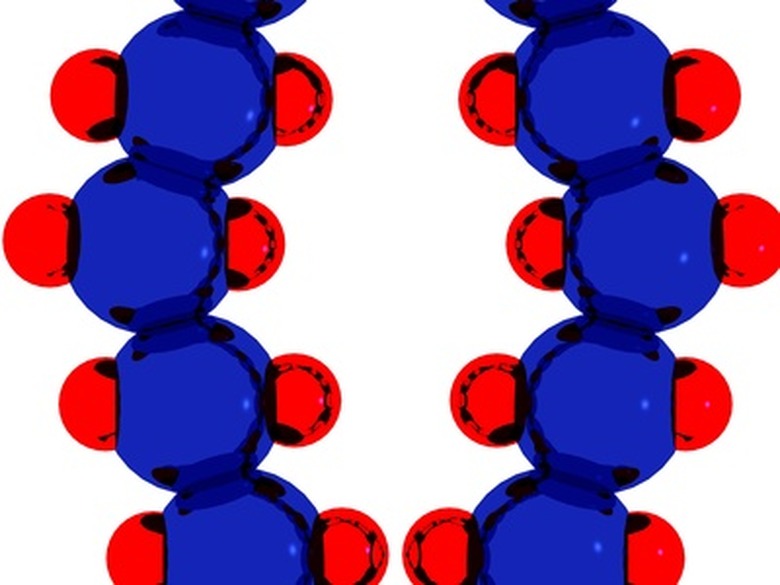How Do Atoms Come Together To Form Molecules?
Atoms exist around us–in the air, the Earth and in living things. Naturally occurring elements, such as oxygen, gold and sodium, are atoms of different forms, and each with a unique number of electrons, protons and neutrons. The protons and neutrons make up the central core of the atom, while the electrons circle the core in defined orbitals called energy levels. Very few atoms have the quantity of electrons they need, so to get their full complement of electrons, they'll bond with other atoms to form molecules.
Facts
Facts
Electrons group themselves in pairs in their energy levels. To calculate the number of electrons allowed in any energy level, find the square of the number representing the energy level and multiply it by two. Using this formula, atoms can have two electrons in their first energy level, eight in the second, and eighteen in their third. The quantity of electrons at each level grows as the number of the energy level increases.
Molecular Formation
Molecular Formation
Electrons form pairs at the lowest energy level first and work their way outward. An atom with unpaired electrons in the outermost energy level attracts other atoms with unpaired electrons to obtain its full complement of electrons. Unpaired electrons in the highest energy level are called valence electrons; when the valence electrons from two or more atoms form pairs, they are not lost from one atom and gained by another. The atoms share their valence electrons and bond together, forming a molecule.
Example
Example
An atom of oxygen has two electrons on the first energy level and six on the second. To be stable, the atom needs two more electrons in the second level. It naturally attracts other atoms with unpaired electrons, such as hydrogen, which has only one electron. In a simplified model of a water molecule, two atoms of hydrogen share their valence electrons with an atom of oxygen. The three atoms bond together, forming a stable molecule. Each atom of hydrogen has two electrons and the oxygen atom has eight.
The Periodic Table
The Periodic Table
The Periodic Table of Elements lists all known elements and their atomic characteristics. Each box in the chart represents one element; the atomic number at the top of each box tells how many electrons the element contains.
Noble Gases
Noble Gases
The right-most column of the Periodic Table shows the elements known as the Noble Gases, which don't form molecules because all their electrons are paired and all the energy levels are full–they exist naturally in their most stable form.
References
- "Chemistry"; Karen Timberlake; 2009
- "Chemistry"; Anthony Wilbraham, Dennis Staley, Candace Simpson and Michael Matta; 1993
- "Chemistry for Dummies"; John T. Moore, Ed.D.; 2003
Cite This Article
MLA
Chipera, Angie. "How Do Atoms Come Together To Form Molecules?" sciencing.com, https://www.sciencing.com/do-come-together-form-molecules-6510735/. 24 April 2017.
APA
Chipera, Angie. (2017, April 24). How Do Atoms Come Together To Form Molecules?. sciencing.com. Retrieved from https://www.sciencing.com/do-come-together-form-molecules-6510735/
Chicago
Chipera, Angie. How Do Atoms Come Together To Form Molecules? last modified March 24, 2022. https://www.sciencing.com/do-come-together-form-molecules-6510735/
